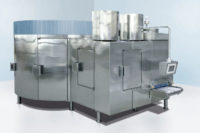Plan for Profit
If there’s one thing we can agree on, it’s that today’s small and mid-sized business owners don’t have it easy.
While the majority of business owners in the meat and poultry processing industry may be experts on the industry, running the day-to-day operations of the business is often overwhelming for many of them. For instance, many get too caught up in the short-term details and lose sight of the big picture – the real role of a business owner. External issues consume their focus, when their attention should be focused on addressing the needs of their own business and managing for profits.
The first and most important question you need to ask as a business owner or manager is: Are we profitable? And if not, how can we be profitable?
Business owners need to stop living on residual profit, or what’s left over, and implement a business model that ensures profit.
How much do I want to make, and how can I get there? The answer is simple – plan for profit. This can be done by adhering to a planned profit model – a simple equation that ensures you act today, but plan for tomorrow.
Revenue – Profit = Expenses
Profit should not be a result or an outcome. Profit should be looked at first. However, most managers don’t realize that profit is a number that can be decided upon, as a fixed input variable, determined and controlled in advance. Too many businesses use a model that places profit as the result, and don’t know how much money they have generated (or lost) until the accounting period ends.
What do I want my profit to be? How much revenue will it require? And, what expenses can I cut?
While you can’t cut your way to profitability, you can control costs and increase productivity.
The trick is finding which costs can be cut or controlled and how to do it. The same goes for the production. An efficient business eliminates wastes within the operation. Such waste includes:
• Labor inefficiencies, such as too many employees, improper allocation of personnel for jobs, and scheduling problems.
• Material inefficiencies, including poor purchasing decisions, cost issues, and wasted materials.
• Service inefficiencies, both on part of the business not serving customers effectively, as well as vendors providing ineffective services, such as marketing services that don’t provide sufficient ROI.
• Inventory control, which includes having too much inventory, not having inventory where it is needed, and having too much cash tied up in inventory.
Any business owner can perform better if he or she implements a strategic planned profit model and remembers three key ideas:
• Data Warehousing – This is a fancy, computer-oriented term for something that smart owners have done for years; remembering past experience to improve current and future performance. The concept of Data Warehousing is a natural next step after starting to use Business Intelligence. Once you have the data, store it so that it can be used to plan and compare against future work. Your corporate memory will prove to be critical to avoiding decisions that may have negative ramifications and which should have been learned from the past.
• Key Performance Indicators – KPIs are the number of customers served per day, the amount of cash brought in per week, and the quantity of widgets sold per period.
All of these factors are why many owners and managers turn to professional business management consultants to help them find the problem areas of their businesses and provide them with the tools to fix it. A key reason for using professional assistance is the fact that outsiders bring an objective viewpoint. Owners or managers of a troubled business may be reluctant or unable to identify problems or offer a lasting solution, since they may be largely responsible for the problems to begin with. When business owners invest in professional consulting expertise, they can receive the greatest return on that investment – a profitable business for years to come.
Looking for a reprint of this article?
From high-res PDFs to custom plaques, order your copy today!






